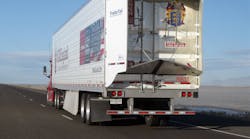For the first time, the federal government will regulate the fuel efficiency and greenhouse gas emissions of vehicles that do not contain engines. Trailer aerodynamics, rolling resistance, and tare weight all impact fuel consumption of the tractors that pull them. That’s why regulators chose to include trailers in Phase 2 of regulations aimed at medium- and heavy-duty commercial trucks.
The proposed rule will set CO2 emissions and fuel consumption standards for manufacturers of new trailers. The rule is scheduled to take effect with the 2018 model year and would be voluntary for trailer manufacturers until the 2021 model year.
The future of fuel economy
Click the links for stories on:
GHG Phase 2: Taking the next step
Engines: Power and efficiency
Trucks: Match game
Operations: Finding an edge
Once the rule kicks in, the requirements will become increasingly stringent until the full impact of the regulation takes effect with the 2027 model year. At full strength, the rule is expected to improve fuel economy between 3% and 8% with a corresponding reduction in greenhouse gas emissions.
The proposal will impact the vast majority of highway trailers. Vans will be the primary target in part because every conventional means of reducing fuel consumption—aerodynamic devices, low rolling resistance tires, automatic tire inflation systems—can be applied to them. In fact, the proposal creates nine different categories of vans and puts everything else in one big bucket—“non-box trailers.”
Here is how the rule will categorize the affected trailers:
◗ Long box trailers (dry-freight vans) longer than 50 ft.
◗ Long box refrigerated trailers (longer than 50 ft.)
◗ Short box (50 ft. or less) dry-freight vans
◗ Short box (50 ft. or less) refrigerated vans
◗ Partial-aero long box dry vans
◗ Partial-aero long box refrigerated vans
◗ Partial-aero short box dry vans
◗ Partial-aero short box refrigerated vans
◗ Non-aero box vans (all lengths of dry and refrigerated vans)
◗ Non-box trailers (tanker, platform, container chassis, and all other types of highway trailers that are not box trailers)
The potential for fuel savings varies by trailer design and operation. Recognizing this, National Highway Traffic Safety Administration and Environmental Protection Agency (EPA) performance levels will vary by trailer type. For example, partial aero trailers—those trailers that have liftgates or other equipment that limit the ability to install full aerodynamic devices—will not be able to manage aerodynamic drag as effectively. The same is true for shorter trailers. Because shorter trailers tend to be used in local delivery operations where speeds are lower, the potential for reducing aerodynamic drag may be less.
The proposed rule completely excludes several types of trailers, including certain logging and mining trailers, heavy-haul trailers, and trailers, such as fracking trailers, where the primary function of the trailer is performed while stationary.
Under the proposed structure, trailer manufacturers would have to obtain a certificate of conformity from EPA before bringing new trailers to market.
The certification process the agencies are proposing for trailer manufacturers is similar to the process for the tractor program. This structure involves precertification activities, the certification application and its approval, and end-of-year reporting.
Trailer manufacturers have several options to test for compliance, including:
◗ A customized GEM vehicle simulation model that EPA developed for the Phase 1 program. The agency has developed an equation based on GEM that calculates CO2 and fuel consumption from performance inputs, but without running the model. Trailer characteristics that a manufacturer would supply to the equation include aerodynamic improvements such as change in the aerodynamic drag area, tire rolling resistance, the presence of an automatic tire inflation system, and the use of lightweight components from a predetermined list. The use of the equation would quantify the overall performance of the trailer in terms of CO2 emissions and fuel consumption on a per ton-mile basis.
◗ A general certification process. Under the proposed process for certification, trailer manufacturers would be required to apply to EPA for certification and would provide performance test data. Trailer manufacturers would submit their applications through the EPA VERIFY electronic database, and EPA would issue certificates based on the information provided.
At the end of the model year, trailer manufacturers would submit an end-of-year report to the agencies to complete their annual obligations.



